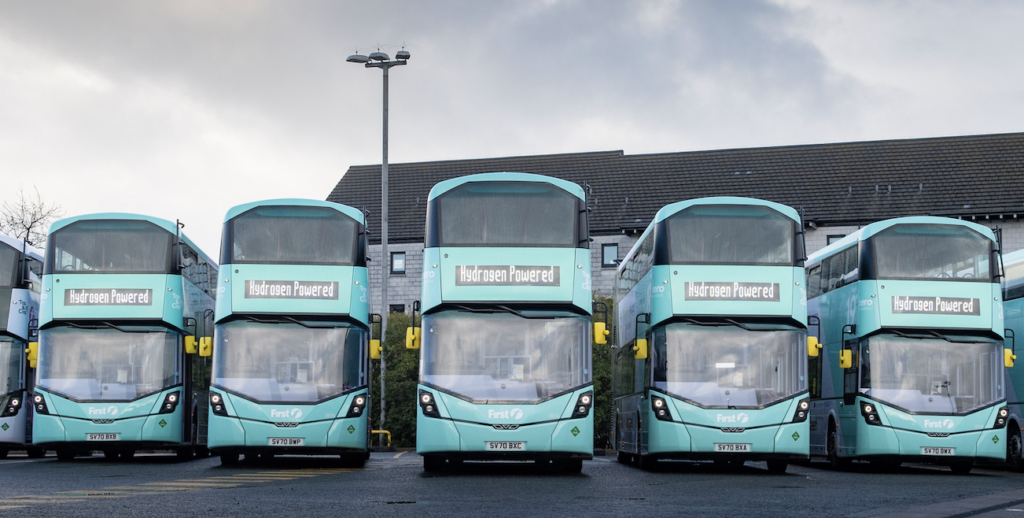Hydrogen’s high energy content and its multiple zero carbon production pathways combine to make it a central pillar of any serious decarbonisation plan, writes Jo Bamford
Hydrogen fuel cell technology is ready to be rolled out now in the commercial sector. The UK government’s target to reach carbon neutrality can provide the foundation for the country’s economic recovery as we emerge from the pandemic. Interestingly, the transport sector which has been majorly impacted by lockdowns and lower passenger demand is ripe for uptake of newer business models involving lower upfront capital expenditure whilst delivering on local air quality and carbon free travel solutions.
Hydrogen’s high energy content and its multiple zero carbon production pathways combine to make it a central pillar of any serious decarbonisation plan. The ever-decreasing price of wind and solar power has created the perfect ecosystem for large scale production of green hydrogen in the UK. From a geopolitical standpoint, we have a remarkable opportunity to set up long lasting infrastructure for energy self-sufficiency.
Key advantages of hydrogen as a transport fuel
Hydrogen has high energy density – which means it is suited to even challenging applications such as heavy use vehicles (e.g. taxis) and in particular heavier vehicles such as buses, trucks and trains.
Hydrogen vehicles can be fuelled rapidly. As a gas, hydrogen can be pumped onto a vehicle in roughly the same time it takes to refuel a conventional vehicle – this makes it particularly suitable for customers who prefer rapid refuelling as compared to a battery electric vehicle and government should ensure that the market can provide this choice.
What’s more, hydrogen can be generated from multiple zero carbon sources. These include renewable electricity (thereby encouraging renewable energy deployment by improving business cases), any hydrocarbon coupled with carbon capture and storage, (leading to neutral or even negative emissions), and even from nuclear sources, all of which lead to an essentially zero carbon fuel.
Hydrogen is also affordable – a recent study by the Hydrogen Council of leading global companies with an interest in hydrogen demonstrates that, by 2030, “Commercial vehicles, trains, and long-range transport applications will compete with low-carbon alternatives” due to reductions in cost driven by scaling up the hydrogen mobility sector.
Allowing progress to happen
At this critical juncture when the international community is taking firm steps to address climate action, several small adjustments at the local and national levels, particularly in the short term, will be imperative for driving investment in hydrogen based zero emission transport. For example, in the UK potential reform to the Bus Service Operators Grant (BSOG) and Renewable Transport Fuel Obligation (RTFO) should support green technologies rather than diesel fuel.
Significant hydrogen refuelling infrastructure needs to be built to give operators the confidence to begin to transition their fleets to zero emission models. Until there is clear evidence of this, orders for diesel buses are likely to prevail over new zero emission models. At the same time as introducing regulation on the sale of new diesel buses, investment must begin in the necessary infrastructure. In many cases, the roll out of new hydrogen buses in the UK is being held up by the lead time required for refuelling infrastructure – up to two years in some cases. Refuelling infrastructure must be developed in parallel and even in advance of the roll out of hydrogen buses for operators to be able to place order for new buses with confidence.
It is known that zero emission propulsion systems are more expensive today. To unlock tomorrow’s pricing today, the entire value chain on the supply and demand side will be required to take an integrated approach. By committing to a defined roadmap for transition of entire bus fleets, bus operators will provide necessary demand signals to enable infrastructure players to build production and refuelling facilities to meet future fuelling demands. This will also give the bus manufacturers better leverage over their supply chain partners through longer term procurement deals.
As the UK economy begins to turn the corner, new business models will emerge. A case in point is the model suggested by the CPT, which is working with major bus operators such as Wrightbus – alongside private financiers – to pioneer an innovative bus leasing model which would significantly reduce the financial burden of transitioning to zero emission buses.
This model will enable operators to lease new zero emission buses on a monthly basis, rather than having to purchase buses outright, thereby reducing upfront costs and improving cash flow whilst passenger numbers remain low. Such an approach could accelerate the transition to a zero-emission bus network in the UK, increasing orders for zero emission buses, and supporting bus manufacturers in turn.
Finally, as a catalyst for change, the government should set a clear and ambitious trajectory for the whole bus network in the UK to reach zero emissions by 2050. Zero emission buses must start to be rolled out now if the UK is to stand a chance of replacing the whole fleet of buses in the UK – approximately 40,000 buses in total. At present, only around 500 of these buses are zero emission models.
Green entrepreneur Jo Bamford is one of Britain’s most significant business leaders, ensuring zero-emission transport is at the top of the political and consumer agenda. Jo rescued Wrightbus from administration in 2019 and turned it into one of the most innovative bus manufacturers anywhere in the world, creating the planet’s first hydrogen double-decker bus and generating orders from London to Aberdeen.
Source: https://greenfleet.net/




